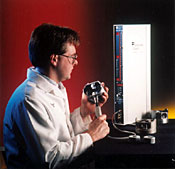"Gaging columns can be a versatile and cost-effective choice, particularly with today's roster of sophisticated features on your benchtop."
– Jack Gaughan
The gaging column of the 21st century doesn't look that different from models produced 60 years ago, but the new features they offer are worlds apart.
ENHANCE YOUR BENCHTOP GAGING SYSTEM

With current digital technology, microcomputer processors inside the gaging columns can be programmed for many applications and functions. Measurements can be displayed as whole numbers, deviations from a nominal size, and in inch or metric units. Multiple gaging tools can be used simultaneously, or one tool can make several measurements during one pass. Other advanced features include automatic recognition, multilingual display, downloadable data, increased memory capacity, and automatic reset.
With automatic recognition, an operator can have three or four single-element gages on the bench plugged into one column. By introducing a part to one of the gages, or one gage to a part, the column display shows results of the feature being measured. It "recognizes" the characteristic being measured and displays that result.
The advanced units feature multilingual display capability, an advantage for international operations that use the same measurement systems in plants in different countries. This feature also provides employees with language choices for easier use.
Another important development is RS-232 output. Measurement data can be sent to a printer, network, or other data-gathering device, and stored for future use or analysis.
Advanced gaging columns also store application programs directly in the column. This helps companies that frequently change applications of the columns by saving approximately 5 to 10 minutes of programming time when a different setup is required. Some units store up to six set- ups or can download them for storage on a PC.
Some new columns feature auto reset, in which an operator puts a part on the gage and the column displays a dimension. That dimension is held on the display, and when the part is again placed on the gage, the unit recognizes it automatically. For example, if a measured bore is too small, the operator can modify it and gage it again without resetting the amplifier.
Current columns also offer different modules for various measurement applications. A sophisticated setup, for example, is two-channel air and electronic gaging. Two separate single- element air gage tools are plugged into a single amplifier, which is economical for the match- gaging application often used in assembly operations. If a hole with a shaft that fits the hole is being measured, the diameters must match. In match gaging, the column displays clearance and interference without physically fitting the parts together. This is a popular measuring process for use on such parts as valves and injectors.
Assessing your application
When developing a gaging system, deciding on the instrument to use should be based on tolerance to be measured, measurement application, desired results, and price. Gaging columns are most suitable for part tolerances of 0.020 inch and less. Typical tolerance parameters for columns are less than 0.003 inch. They are for use with single-element and multiple-characteristic gaging applications. Several parts can be connected to multiple probes on a single-gaging column or a single part could have multiple features gaged. Gaging columns are widely used in snap gage and bore gage applications, in which outer diameters or inner diameters of parts are measured directly on the machine tool. The column gage provides instantaneous results, indicating whether the part is approaching size, is good, or is bad, according to operator-set tolerance limits. The cost of a high-quality column gage can be as much as $1,500. Even at this price tag, a column gage can be an affordable alternative to the manufacturer who might be considering buying a high-end automated gaging system that can be 7 to 10 times more expensive.
If tolerances are greater than 0.020 inch, vernier calipers may be the answer. If the application is produced in low volumes, dial indicators could be the best solution. Cost plays a role in the decision of whether to use a column gage. If a $200 handheld gage can do the job, it isn't necessary to spend more on a column and probe if the job doesn't have tight tolerances or there is no need to maintain records at production pace. The measurement goals must be considered as well. Columns provide discreet light-emitting diode resolution that is amplified greater than the tolerance being measured. They don't provide trend analysis or indicate whether a process is good or bad. They simply display whether the part being measured is within preset tolerance limits. Where appropriate, gaging columns are a versatile and cost-effective choice, particularly with today's roster of sophisticated features on your benchtop.
Deciding on a column gage
Diesel Recon (Memphis, TN) is a subsidiary of Cummins Engine. They are in the business of producing reconditioned diesel engines. They face many challenges, including keeping parts costs low while maintaining high-performance standards. To meet industry standards, all parts must meet tolerances to within 10% of normal deviation. To meet business goals, they must maintain maximum profitability.
In the water pumps for the diesel power plants they manufacture, Diesel Recon found it necessary to replace three different types of shafts. However, replacing the parts with new shafts was too costly, so they investigated reconditioned shafts. But the company was concerned about maintaining high quality standards. Each shaft would have to be tested thoroughly, quickly, and accurately to meet production demands.
The quality engineering team at Diesel Recon researched testing options that met their criteria. Most gages simply would not provide fast gaging time, easy reconfiguration between shaft styles, and the tight tolerances required. Their search for the best solution led them to look into electronic gaging systems.
Diesel Recon purchased a custom designed, semiautomatic, adjustable electronic water pump shaft gage. The system had a bench-mounted column gage, interchangeable tooling sets with LVDT probes and part duplicating minimum and maximum master sets for each part. The gage's programmable microprocessor receives data from the transducer probe inputs, evaluates the data, outputs the gaging results as good or reject, then sends the data into an RS-232 output signal stream for further analysis.
Shafts are manually loaded into the gage's tooling fixture. The operator resets the gage and a drive wheel rotates the shaft. The gaging cycle is completed with the gage operating in a dynamic TIR (Total Indicator Readout) mode. Gage calibration is performed with the minimum and maximum master set. The gaging is usually completed in a 10-second cycle time, for measurement of tolerance at 5 locations and two runouts.
"The gaging is quick, accurate, and easy to maintain," said Malcolm McIntosh, senior quality engineer for Diesel Recon.
Flexible use
The programmable nature of the unit allows Diesel Recon to change specifications readily without new gages. Because they must frequently shift between the three different shaft sizes, the rapid reconfiguration of the gage system means the difference between a few minutes with the column gage, and up to 1 hour or more for other gaging.
Perhaps the most noticeable difference is in the accuracy. When Diesel Recon first put the gage online, they were achieving a respectable 50% reclamation rate for the parts. Not satisfied, however, they further analyzed the output data and determined that some parts were being rejected. This was because the unit was so accurate that it included the slight residual film of protectant that intentionally remained on the parts after a cleaning process. After changing settings by 0.0002 inch, the useable reclaimed parts increased to 70%.
Quality Tech Tips
- Column gages allow for multiple tools to be used simultaneously.
- The switch from air-based to electronics-based technology has increased column gage functionality.
- Suitable for part tolerances of 0.020 inch and less.
- Doesn't provide trend analysis, or indicate whether a process is good or bad.
Jack Gaughan is Vice President, Sales Marketing at Edmunds Gages (Farmington, CT). He may be contacted at (860) 677-2813 or jgaughan@edmundsgages.com
By: Jack Gaughan
Vice President
Sales & Marketing




A New Dimension In Precision Measurement
.
(860) 677-2813
Toll Free 877-521-5818